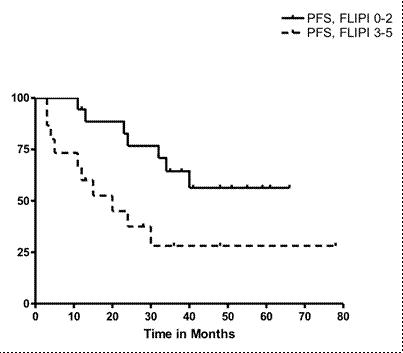Abstract
Standard therapy for patients (pts) with untreated HTB indolent NHL includes rituximab combined with cytotoxic chemotherapy. There remains a deficiency of prospective data examining non-cytotoxic options. We examined long-term outcomes and prognostic factors for indolent NHL patients with HTB treated with front-line rituximab and bortezomib therapy.
We conducted a multicenter prospective phase II clinical trial for untreated indolent NHL pts (NCT 00369707). All pts were required to have HTB as defined by Groupe D’Etude des Lymphomes Folliculaires (GELF) criteria. Induction therapy consisted of 3 cycles of: rituximab at 375 mg/m2 x 4 weekly doses for cycle 1, then only day 1 for cycles 2 and 3 combined with bortezomib 1.6 mg/m2 days 1, 8, 15, and 22 given q35 days for all 3 cycles. This was followed by an abbreviated maintenance with both drugs given once q2 months x 8 months. Staging was done via CT with international workshop1999 criteria. All efficacy endpoints and survival rates were analyzed by intent-to-treat (ITT). Additionally, we examined prognostic factors for associations with survival on univariate analyses.
42 pts were enrolled and all pts were evaluable for toxicity and efficacy. Histologies were follicular lymphoma (FL) (n=33, 79%), marginal zone lymphoma (MZL) (n=6, 12%), small lymphocytic lymphoma (SLL) (n=2, 7%), and Waldenstroms (n=1, 2%). Median age was 62 years (40-86) with 21% of pts age >70 years; 91% of pts had advanced-stage disease (67% stage IV). Additional characteristics included: B symptoms in 31%, 38% with bulky disease (>7cm), and malignant ascites or effusions were present in 19%. The median FLIPI was 3 (61% were 3-5). Overall, therapy was well tolerated with minimal cytopenias noted. Most adverse events (AEs) occurred during the 3 induction cycles. Grade 3 AEs were: fever (5%), infusion reaction (5%), infection (5%), cardiac (5%), and fatigue (5%), as well as diarrhea, hypokalemia, and bowel obstruction each at 2%. The only grade 4 AEs were neutropenia (5%) and thrombocytopenia (2%); 3 pts were taken off study early (each after 1 cycle of induction) due to grade 3 diarrhea, fatigue, and cardiac AEs (latter due to CHF exacerbation, deemed unrelated to therapy [pt autonomously stopped cardiac medications]). Following the 3 induction cycles, the overall response rate (ORR) on ITT was 69% for all pts with a complete remission (CR) rate of 24% (FL ORR 70%, CR 23% on ITT). The ORR at end of therapy for all pts was 69% with 39% CR, while for FL, the end of therapy ORR was 75% and CR 44%. With a median follow-up of 48 months (10-78) and on ITT, the 4-year progression-free survival (PFS) for all pts was 44% with a 4-year overall survival (OS) rate of 87%. The 4-year PFS and OS rates for FL patients were 44% and 97%, respectively (Figure 1). Further, the 4-year OS rate for FL pts was significantly better compared with non-FL pts (97% (95% CI 80%, 99%) versus 43% (95% CI 6%, 78%), respectively, P=0.003). The time-to-treatment failure rate at 4 years for all pts was 26%, which was primarily due to the aforementioned AEs resulting in study removal and several non-progressing pts taken off study at physician discretion. Analyzing predictors of survival on univariate analysis, there was a trend for FLIPI to impact PFS of FL pts (HR: 1.48, 95% CI 0.95-2.32, P=0.08) as well as OS (HR: 3.34, 95% CI 0.89-12.56, P=0.08). Further, OS was similar, but PFS rates for FL pts were significantly different by low and high-risk FLIPI groups (Figure 2); 4-year PFS for FLIPI 0-2 was 57% (95% CI 29%, 77%) vs 28% (95% CI 8%, 53%) for FLIPI 3-5 (P=0.02). In addition, FL histology had a significant effect favoring lower risk of death vs non-FL histology (OS HR: 0.07, 95% CI 0.01-0.70, P=0.02).
In pts with untreated HTB NHL, therapy with rituximab/bortezomib was well tolerated and survival rates for FL pts approximated that of prior rituximab/cytotoxic chemotherapy series that have reported long-term outcomes of this pt population (e.g., R-CVP induction: Marcus R et al J Clin Oncol 2009). Moreover, OS for FL pts here was excellent, while OS for non-FL pts was sub-optimal. Continued strategies to incorporate novel therapeutic agents into frontline FL are warranted in part to delineate untreated HTB indolent NHL pt populations that may achieve long-term survival without use of cytotoxic therapy.
Evens:Millennium: Consultancy, Honoraria. Off Label Use: Bortezomib in follicular lymphoma.
Author notes
Asterisk with author names denotes non-ASH members.



This feature is available to Subscribers Only
Sign In or Create an Account Close Modal